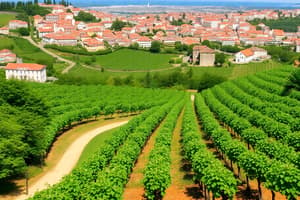Podcast
Questions and Answers
In which part of Europe is Portugal located?
In which part of Europe is Portugal located?
- Northeastern
- Southwestern (correct)
- Northwestern
- Southeastern
What is the approximate total area of Portugal?
What is the approximate total area of Portugal?
- 100,000 km²
- 70,000 km²
- 92,390 km² (correct)
- 120,000 km²
What is the main occupation from Portugal's Age of Discoveries?
What is the main occupation from Portugal's Age of Discoveries?
- Exploration and colonization of Asia, Africa, and the Americas (correct)
- Defending against the Moorish occupation
- Establishing trade routes with the Roman Empire
- Exploration and colonization of Europe
What is the capital and largest city of Portugal?
What is the capital and largest city of Portugal?
What is the main industry in Portugal's economy?
What is the main industry in Portugal's economy?
What is the famous traditional music in Portugal?
What is the famous traditional music in Portugal?
Flashcards are hidden until you start studying
Study Notes
** Geography and Climate **
- Located in southwestern Europe, bordered by Spain and the Atlantic Ocean
- Total area: approximately 92,390 km² (35,660 sq mi)
- Divided into three main regions: Costa Verde (green coast), Beiras, and Algarve
- Mountain ranges: Serra da Estrela, Serra do Marão, and Serra de Monchique
- Main rivers: Tagus, Douro, and Guadiana
- Climate: Mediterranean, with mild winters and warm summers
** History **
- Early inhabitants: Celts, Tartessians, and Lusitanians
- Roman occupation (2nd century BC - 5th century AD)
- Moorish occupation (8th - 11th centuries)
- Kingdom of Portugal established in 1139
- Age of Discoveries (15th - 16th centuries): exploration and colonization of Asia, Africa, and the Americas
- Portuguese Empire (16th - 20th centuries): colonies in Africa, Asia, and South America
- Modern era: republic declared in 1910, Carnation Revolution in 1974, and EU membership in 1986
** Economy and Demographics **
- Economy: high-income advanced economy, strong in services, industry, and tourism
- Main industries: textiles, footwear, wood, and metalworking
- Agriculture: fishing, forestry, and production of wine, olive oil, and cork
- Population: approximately 10.3 million people (2020 estimate)
- Capital and largest city: Lisbon (population: around 505,000)
- Other major cities: Porto, Amadora, and Coimbra
** Culture **
- Official language: Portuguese
- Rich cultural heritage, including Fado music and traditional folk dance
- Influenced by Moorish, Gothic, Manueline, and Baroque architectural styles
- Famous for Port wine, seafood, and traditional dishes like bacalhau à brás and feijoada
- Celebrations: Festa de Santo António (Lisbon), Festa do Avante! (Setúbal), and Festa do Fado (Coimbra)
Studying That Suits You
Use AI to generate personalized quizzes and flashcards to suit your learning preferences.




